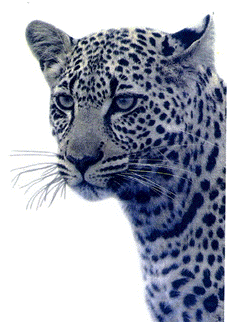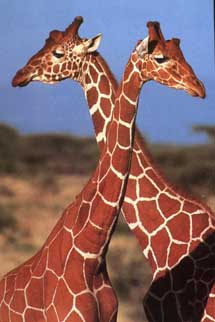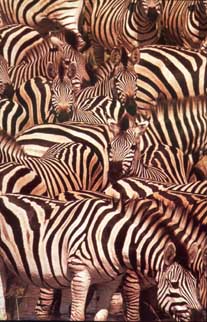
|
 |
 |
The importance of mathematics in certain fields such as physics has been known for a long time but recently its power has also been discovered in biology. Some phenomena that one believed to be owing to chance or to the action of genes are revealed to be the consequence of mathematical dynamics. Perhaps the most spectacular example is that of the pattern on the coats of animals.
Why are the coats of certain types of animals such as the leopard spotted, whereas the coats of others are striped (tiger, zebra). Why are the spots of the giraffe much bigger than and different from those of the leopard? Why do certain animals, such as the mouse and elephant not have a pattern? Why do some animals, such as the cheetah, jaguar, leopard and genet, have spotted bodies and striped tails, but there are no animals with striped bodies and spotted tails?
All of these questions now have a mathematical answer. The model in question describes the way in which two different chemical products react and are propagated on the skin : one which colors the skin, and one which does not color it; or more precisely, one which stimulates the production of melanin (coloring the skin) and one which inhibits this production.
What is remarkable is that the equations show that the different patterns of coat depend only on the size and form of the region where they are developed. Stated in another way, the same basic equation explains all of the patterns. But then, why do the tiger and the leopard have different patterns given that their bodies are similar? This is because the formation of the patterns would not be produced at the same moment during the growth of the embryo. In the first instance, the embryo would be still small and in the other, it would be at a much bigger stage.
More precisely, the equations show that no pattern is formed if the embryo is very small, that a stripped pattern is formed if the embryo is a little bigger, a spotted pattern if it is bigger yet, and no pattern at all if it is too big. This is why the mouse and the elephant would not have a pattern.
What's more, as to comparable surfaces, the form of the surface makes a difference. Thus, if one considers a certain surface large enough in order to permit the formation of spots, and that one gives it a long, cylindrical form (like a tail) without altering its total area, then the spots are transformed into stripes.
In this way, a unique system of differential equations seems to govern all the coat patterns that one finds in nature. The same type of equations also permits one to explain the patterns of the wings of butterflies as well as certain colored patterns of exotic fish.
Let's mention nevertheless that the process of chemical diffusion which we have just mentioned (called a diffusion-reaction mechanism) have not yet been directly observed on the skin of animals, although certain indirect evidence seems to confirm their presence. The chemical substances in question would be actually found in the epidermis or just below, and it is very difficult to detect them experimentally. For the moment, then, this model remains a model, although considerable circumstantial evidence seems to confirm it. In any case, that such a model succeeds in explaining almost all the diversity and richness of the patterns occurring on animals is surely a sign that it contains a good deal of truth.
The history of this development is fascinating in its own right. It began in the early 50's with two quite separate strands. On the one hand, lay theoretical work by the famous English mathematician Alan Turing on Morphogenesis not long before he died in 1954. On the other hand, and quite independently, there was the very important experimental work of a Russian biophysicist Boris Belousov. Much of this was either unpublished or unrecognised for many years. Therefore, the theory of reaction-diffusion lay dormant until around 1968 when a number of strands came together. A Russian biochemist named Anatoly Zhabotinsky had been improving on Belousov's experimental work and Western scientists learnt of it at a symposium in Prague in 1968. Simultaneously, the famous Russian chemist Ilya Prigogine and Rene Lefevre following up Turing's work formulated and analysed a model for a chemical self-organising reaction, which fitted in with some of Prigogyne's earlier work. This earlier work showed that the spontaneous creation of order is not forbidden by the Second Law of Thermodynamics, and later played a significant role in Prigogine's 1977 Nobel Prize for Chemistry. Finally, the English mathematical biologist James Murray brought it all together in 1988-89 - see below.
REFERENCES:
A.M. Turing, The Chemical Basis of Morphogenesis, Phil. Trans. R. Soc. London B237, pp.37-72, 1952
A.M. Turing, A Diffusion Reaction Theory of Morphogenesis in Plants (with C. W. Wardlaw) - published posthumously in the third volume
of the Collected Works of A.M. Turing, Elsevier, Amsterdam, 1992. The preceding paper is reproduced in that volume.
NOTE: Turing's term 'Morphogensis' is now more understandably
referred to as 'pattern formation'.
J. Tyson, The Belousov-Zhabotinsky Reaction (Springer-Verlag, Heidelberg, 1976)
I. Prigogine and R. Lefevre, J. of Chemical Physics (48) p.1695, 1968.
I. Prigogine and I. Stengers, Order out of Chaos (Heinemann, London, 1983)
J. D. Murray, How the leopard gets its spots, Scientific American, March 1988, p. 80
J. D. Murray, Mathematical Biology (Springer-Verlag, Berlin,1989)
© Mathematics and Knots, U.C.N.W.,Bangor, 1996 - 2002
This material may be used freely for educational, artistic and
scientific purposes, but may not be used for commercial purposes,
for profit or in texts without the permission of the publishers.